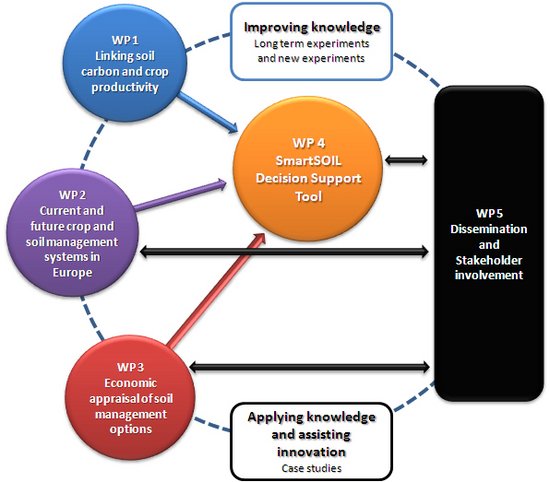Overall strategy and general description
The work programme is organised according to the work packages (WP) described below, with the inter-relationship expressed in the project diagram given at the bottom of this page.
Linking soil carbon with soil functions and crop productivity (WP1) | ||
John R. Porter lead of WP1 | WP1 will use existing soil, crop and management data from long-term experiments (LTEs) combined with targeted experiments in these LTEs to increase knowledge on the separate effects of SOC flows and stocks on crop productivity and other ecosystem services. WP1 will identify state-of-the-art models to map carbon flow and stock and their associated effects on soil properties and functions and thereof on crop productivity and carbon sequestration in diverse European arable production systems. The identified models will be tested with the available LTEs datasets. WP1 will further use the available datasets and models to appraise effects of SOC flows and stocks on other ecosystem goods and services. | |
Current and future crop and soil management systems in Europe (WP2) | ||
Peter Kuikman lead of WP2 | The quantification of SOC balance from inputs and outputs for agricultural land with crop and soil management being an integral part of farming systems management will be done with the simple model developed in WP1. The MITERRA-Europe framework will be used to quantify the different fluxes of C to and from the soil and to assess the effects of soil management practices on SOC and regions with soils at risk. The simplified model (derived from WP1 with input from the MITERRA framework and verified with data from case studies and process models on carbon dynamics) will then be used to develop trends across EU27. WP2 then delivers data and maps with regions and practices that put soils at risk provided continuation of “business as usual” soil management and scenario analysis of impact of alternative crop and soil management practices. | |
Economic appraisal of soil management options (WP3) | ||
Dominic Moran lead of WP3 | Economic appraisal of soil management interventions will be undertaken in WP3, which will consider both the valuation of soil ecosystem goods and services and the economic efficiency of alternative management measures to deliver ecosystem services in different locations. In this context economic efficiency can be judged in terms of relative cost-effectiveness of delivering different bundles of ecosystem services (e.g. quantified as an index) in specific locations, or a wider cost-benefit analysis using a carbon price and/or monetary values for other goods and services. These values will be partly derived from the existing literature for use in benefits transfer, and from specific valuation studies to be conducted as part of the project. The overall aim here is to guide advice to the development of decision support tools and policy more generally. | |
SmartSOIL decision support tool (WP4) | ||
Sandra Nauman lead of WP4 | WP4 will develop a scientifically validated and user-friendly decision support tool (DST) in an iterative process, which will capture the interaction and demonstrate the synergies between management practices and carbon flows/stocks and crop yields. The SmartSOIL DST will help farmers, advisory and extension services (farm level) and policy makers (regional level) to discuss and select the most suitable management practices and technologies adapted to different European soils and bio-geographic conditions | |
Dissemination and stakeholder involvement (WP5) | ||
Julia Ingram lead of WP5 | WP5 will coordinate stakeholder consultation in six case studies across Europe. It aims to identify barriers, opportunities for, and impacts on, producers of implementing the crop and soil management measures identified in WP2 and WP3 as optimal for productivity and carbon storage, and cost effectiveness. It will propose a dissemination strategy and disseminate outputs from the project, including the SmartSOIL DST and Toolbox, to different categories of beneficiaries. | |





